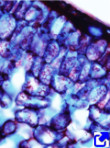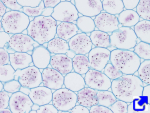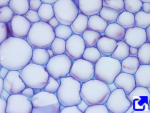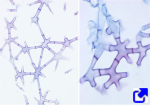Parenchyma is a tissue involved in a wide variety of functions, including photosynthesis, storage, synthesis of organic compounds, and tissue renewal. It consists of a single cell type: the parenchyma cell. Parenchyma tissue is found in the cortex and medulla of shoots and roots, leaf mesophyll, pulp of fruits, and seed endosperm. Parenchyma cells are also found as components of the vascular tissues: phloem and xylem.
According to their functions, four types of parenchyma tissues are found:

Photosynthetic parenchyma, or chlorenchyma, is specialized in performing photosynthesis, which is carried out by the many chloroplasts found in the cytoplasm of its cells. The photosynthetic parenchyma is commonly found under the epidermis, where the light is intense. This tissue is primarily located in leaves and peripheral region of green stems. The photosynthetic parenchyma of leaves is known as the mesophyll.

Storage parenchyma synthesizes and stores substances. Starch is the most common storage compound.

Aquiferous parenchyma. While all plant cells are able to accumulate more or less water intracellularly, the aquiferous parenchyma cells are specialized in this function, which is critical for xerophyte plants (those living in dry environments). Aquiferous parenchyma may be regarded as a very specialized form of storage parenchyma.

The aeriferous parenchyma, or aerenchyma, shows large intercellular spaces connected to one another, allowing gases to be conducted within the tissue. This feature is necessary for hydrophytes (living in waterlogged and aquatic environments) in order to aerate the plant organs.
-
Bibliography ↷
-
Evans DE. 2003. Aerenchyma formation. New phytologist. 161:35-49. DOI: 10.1046/j.1469-8137.2003.00907.x.
Fradera-Soler M, Grace OM, Jørgensen b, Mravec J. 2022. Elastic and collapsible: current understanding of cell walls in succulent plants. Journal of experimental botany. 73: 2290-2307. DOI: 10.1093/jxb/erac054.
Pruyn ML, Spicer R. 2012. Parenchyma. In: eLS. John Wiley & Sons, Ltd: Chichester. DOI: 10.1002/9780470015902.a0002083.pub2.
Seago JR JL, Marsh LC, Stevens, KJ, Soukup A, Votrubová O, Enstone D. 2005. A re-examination of the root cortex in wetland flowering plants with respect to aerenchyma. Annals of botany. 96: 565-579. DOI: 10.1093/aob/mci211.
-
 Meristems
Meristems 